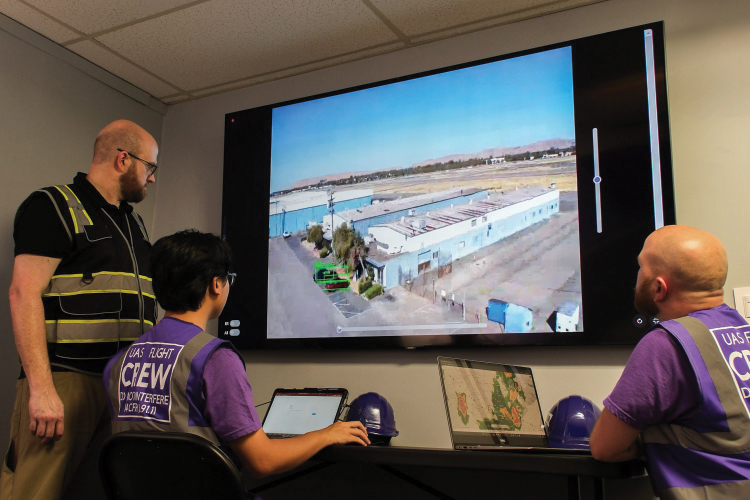The energy industry has steadily adopted drone technology over the past decade, with many regulatory hurdles either overcome or actively being addressed. Drones are used to monitor and inspect critical power generation sites and sprawling transmission networks. They are being deployed in the face of threats to infrastructure – human or natural – to reduce the need to put personnel in harm’s way.
Most investor-owned utilities now have a drone program, and many smaller or publicly owned utilities are on their way. However, in the current state of the drone industry, there is sometimes an uphill battle to justify the Return on Investment (ROI) of scaling up drone technology. This
is largely because, at present, personnel must be on location to operate drones – ironic seeing as they are supposed to be autonomous or uncrewed systems. Although drones can help personnel see elevated or dangerous places, their value is hampered by the selfie-stick nature of how they are used today.
Beyond Visual Line of Sight (BVLOS) is the first step in enabling drones to be operated remotely and detect energy infrastructure issues without a person being on location. A remote operator with the right software and processes can tap into any location on demand. With BVLOS, operators can inspect critical infrastructure from wherever they choose – even at home on the couch. The transition to BVLOS can unleash never-before-seen volumes of data that enable energy infrastructure companies to anticipate and prevent security and safety issues.

BVLOS drone intel with real-time computer vision.
Image Credit: Birdstop
The holdup
Since commercial drone regulation emerged in 2016, speculative doubt about BVLOS has persisted. Two myths largely carry these doubts:
1. Myth: BVLOS is binary – either you have it or you don’t.
In reality, there is a world of nuance behind that simple acronym. BVLOS can be segmented into several levels similar to the levels of self-driving car technology. For much of the time since 2016, the flavors of BVLOS still revolved around someone on location - Visual Observer (VO) - making sure safety is met and the airspace is clear. The operator of the drone could be remote but the area of drone operation needed to have a person. Today, the cutting-edge companies in BVLOS are beginning to operate at a small scale without anyone on location. Electronic systems are used to ensure safety and airspace deconfliction remotely. Once this is mastered, the industry can move toward one command center operating many drones at once with the assistance of software and AI.
2. Myth: The regulators are too slow.
In the United States, doing any level of BVLOS requires bespoke approval from the Federal Aviation Administration (FAA). As such, regulation is often blamed for the lack of widespread BVLOS. While the process for obtaining BVLOS approvals can be long and the process opaque, the actual approvals granted are likely not far off what can be safely performed in practice. The discrepancy is more about what the FAA considers safe, which may be more stringent than what the private sector considers safe. As much as the private sector does bemoan the stringent approval process of BVLOS, it is worth noting that less than a decade ago there was no BVLOS of any sort and today BVLOS is at a point of commercial usage.
With increasing BVLOS, existing data processes do need to change to handle the immense volume of data returned by BVLOS operations. A second piece is needed to unlock the full value of drones while eliminating data processing bottlenecks: Computer Vision Artificial Intelligence (CVAI). CVAI will help existing personnel process and analyze the drastically increased volume of data on energy infrastructure.
Together, BVLOS and CVAI unlock the full potential of contemporary drone fleets, saving money, expanding capabilities and ensuring safety.
Safety first
In addition to increasing speed and efficiency, BVLOS drone operations can reduce the need for personnel in precarious situations. According to OSHA statistics, repairing infrastructure is among the most dangerous jobs in America. And, although personnel regularly climb elevated high-voltage structures, most accidents actually occur in transit while personnel are traveling to areas where hurricanes, wildfires, or other natural disasters have affected energy infrastructure. Not only can BVLOS prevent certain trips into the field, but it can also provide situational awareness to personnel
when a trip is unavoidable. If onsite personnel are needed, drone technology is ineffective at protecting workers from travel-related dangers. With renewables projected to grow rapidly through the next decades, towering wind turbines, remote solar fields and radioactive nuclear sites pose maintenance challenges and safety questions that require urgent answers. BVLOS is the solution needed to maintain energy infrastructure while keeping workers safe.
Looking forward
Since the US commercial drone industry began in earnest in 2016, regulators and companies have fought the good fight to enable commercially valuable BVLOS operations. For years it seemed like a pipe dream, but now there are meaningful BVLOS operations providing value to the energy industry. Barring any catastrophic reversal, over the next few years the expansion of BVLOS and AI will allow drone systems to be operated by largely remote personnel, massively shifting how these flying sensors are used and the volume of intel they can produce. This wealth of real-time intel has the potential to create a step shift change in ROI and a transformation in how energy infrastructure is managed at scale.

Keith Miao is the CEO of Birdstop, a remote sensing platform used by enterprise to automate inspection and monitoring workflows. Miao’s background in remote sensing and data science started over a decade ago at the Columbia University Earth Institute. He has a regulatory background from his early career working in Washington DC and a technology background from his later career at Google in California.






